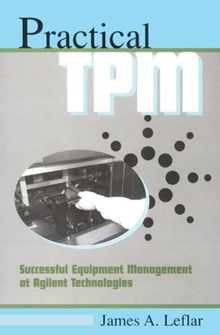
Based on the actual program developed at a leading high-tech company, Practical TPM: Successful Equipment Management at Agilent Technologies recounts the challenges confronted -- and conquered -- by the Agilent TPM team in the implementation process. In so doing, it provides a close-up, first-hand look at a comprehensive TPM system.
Agilent Technologies, formerly Hewlett-Packard's Test and Measurement Division, operates an integrated circuit fabrication plant in Fort Collins, Colorado. Guided by Masaji Taijiri, the author of 7 Steps to Autonomous Maintenance, author Jim Leflar and his team at Agilent developed a complete TPM program for the complex equipment on their shop floor. Drawn from these experiences, Practical TPM is a must read for anyone who wants to begin successful TPM implementation.
Part I explains the fundamental concepts of TPM, including the six basic principles of TPM, the goals of TPM, cultural changes resulting from TPM, and the keys to successful implementation. Part II -- the heart of the book -- describes, in step-by-step detail, the evolution of Agilent's TPM program. Each phase is clearly defined and demonstrated; the working tools and systems developed by the Agilent TPM team in the process are discussed at length. To conclude, Part III focuses on developing a vision and a strategy for your own successful TPM program.
Replete with annotated photographs and illustrations documenting Agilent's successful program, Practical TPM: Successful Equipment Management at Agilent Technologies offers an invaluable roadmap to TPM implementation.
The book covers:
-- A step-by-step TPM program as implemented at a major US corporation
-- The 5-why analysismethod
-- Examples of one-point lessons
-- Using visual controls in a TPM program
-- Tools for understanding equipment failures
-- Improving machine productivity
-- Improvement metrics
-- Master checklists and forms
-- Developing activity boards
-- Appendi